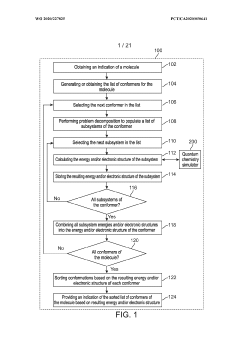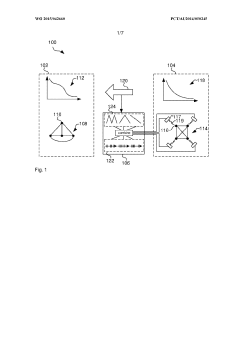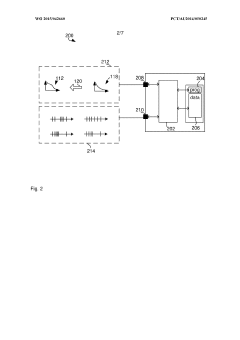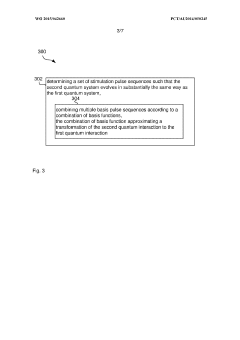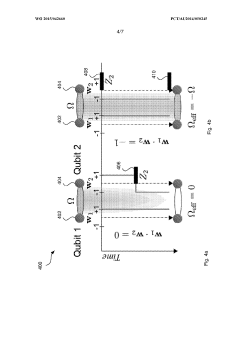Quantum Simulation for Understanding Complex Molecular Structures
JUL 17, 20259 MIN READ
Generate Your Research Report Instantly with AI Agent
Patsnap Eureka helps you evaluate technical feasibility & market potential.
Quantum Simulation Background and Objectives
Quantum simulation has emerged as a powerful tool for understanding complex molecular structures, revolutionizing the field of computational chemistry and materials science. This technology leverages the principles of quantum mechanics to model and predict the behavior of atoms and molecules at the quantum level, offering unprecedented insights into molecular interactions and properties.
The development of quantum simulation can be traced back to the early days of quantum mechanics in the 1920s. However, it wasn't until the advent of powerful computing systems in the late 20th century that practical applications became feasible. The field has since experienced rapid growth, driven by advancements in quantum algorithms, hardware, and theoretical frameworks.
The primary objective of quantum simulation in molecular structures is to overcome the limitations of classical computational methods. Traditional approaches often struggle with accurately representing the quantum nature of electrons and nuclei, especially in large and complex molecular systems. Quantum simulation aims to provide a more precise and efficient means of modeling these intricate quantum interactions, enabling researchers to tackle previously intractable problems in molecular science.
One of the key goals is to enhance our understanding of chemical reactions, molecular dynamics, and material properties at the atomic level. This includes simulating the behavior of molecules in various environments, predicting reaction pathways, and exploring the electronic structure of complex compounds. Such capabilities have far-reaching implications for drug discovery, materials engineering, and the development of new catalysts.
Another critical objective is to bridge the gap between theoretical predictions and experimental observations. Quantum simulation offers the potential to validate and refine theoretical models by providing accurate computational results that can be directly compared with experimental data. This synergy between theory, simulation, and experiment is crucial for advancing our fundamental understanding of molecular structures and their properties.
The evolution of quantum simulation techniques has been marked by several significant milestones. These include the development of density functional theory (DFT), which has become a cornerstone of computational chemistry, and the introduction of post-Hartree-Fock methods for more accurate electronic structure calculations. More recently, the emergence of quantum computing has opened up new possibilities for quantum simulation, promising to tackle even larger and more complex molecular systems with unprecedented accuracy and efficiency.
As the field continues to advance, researchers are focusing on overcoming current limitations, such as the scaling of computational resources with system size and the challenge of simulating strongly correlated electron systems. The ultimate goal is to develop quantum simulation techniques that can accurately model and predict the properties of complex molecular structures across a wide range of scales, from small molecules to large biomolecular assemblies and extended materials.
The development of quantum simulation can be traced back to the early days of quantum mechanics in the 1920s. However, it wasn't until the advent of powerful computing systems in the late 20th century that practical applications became feasible. The field has since experienced rapid growth, driven by advancements in quantum algorithms, hardware, and theoretical frameworks.
The primary objective of quantum simulation in molecular structures is to overcome the limitations of classical computational methods. Traditional approaches often struggle with accurately representing the quantum nature of electrons and nuclei, especially in large and complex molecular systems. Quantum simulation aims to provide a more precise and efficient means of modeling these intricate quantum interactions, enabling researchers to tackle previously intractable problems in molecular science.
One of the key goals is to enhance our understanding of chemical reactions, molecular dynamics, and material properties at the atomic level. This includes simulating the behavior of molecules in various environments, predicting reaction pathways, and exploring the electronic structure of complex compounds. Such capabilities have far-reaching implications for drug discovery, materials engineering, and the development of new catalysts.
Another critical objective is to bridge the gap between theoretical predictions and experimental observations. Quantum simulation offers the potential to validate and refine theoretical models by providing accurate computational results that can be directly compared with experimental data. This synergy between theory, simulation, and experiment is crucial for advancing our fundamental understanding of molecular structures and their properties.
The evolution of quantum simulation techniques has been marked by several significant milestones. These include the development of density functional theory (DFT), which has become a cornerstone of computational chemistry, and the introduction of post-Hartree-Fock methods for more accurate electronic structure calculations. More recently, the emergence of quantum computing has opened up new possibilities for quantum simulation, promising to tackle even larger and more complex molecular systems with unprecedented accuracy and efficiency.
As the field continues to advance, researchers are focusing on overcoming current limitations, such as the scaling of computational resources with system size and the challenge of simulating strongly correlated electron systems. The ultimate goal is to develop quantum simulation techniques that can accurately model and predict the properties of complex molecular structures across a wide range of scales, from small molecules to large biomolecular assemblies and extended materials.
Market Demand for Molecular Structure Analysis
The market demand for molecular structure analysis has been experiencing significant growth, driven by advancements in quantum simulation technologies. This surge is particularly evident in pharmaceutical and biotechnology industries, where understanding complex molecular structures is crucial for drug discovery and development processes. The ability to accurately simulate and analyze molecular structures at the quantum level has opened new avenues for researchers and companies to accelerate their R&D efforts and reduce costs associated with traditional experimental methods.
In the pharmaceutical sector, the demand for quantum simulation tools for molecular structure analysis is primarily fueled by the need to design more effective and targeted drugs. By leveraging quantum simulations, researchers can predict drug-target interactions with unprecedented accuracy, potentially reducing the time and resources required for drug development. This capability is especially valuable in the era of personalized medicine, where tailored treatments based on individual genetic profiles are becoming increasingly important.
The biotechnology industry is another major driver of market demand for quantum-based molecular structure analysis. As the complexity of biological systems becomes better understood, there is a growing need for advanced computational tools that can model and simulate these intricate molecular interactions. Quantum simulations offer the potential to unravel the mysteries of protein folding, enzyme catalysis, and other critical biological processes, which could lead to breakthroughs in areas such as synthetic biology and biocatalysis.
Beyond pharmaceuticals and biotechnology, the materials science sector is also contributing to the increasing demand for quantum simulation in molecular structure analysis. The ability to design and predict the properties of novel materials at the atomic level has far-reaching implications for industries ranging from electronics to energy storage. Quantum simulations enable researchers to explore vast chemical spaces and identify promising candidates for new materials with desired properties, potentially revolutionizing fields such as semiconductor development and battery technology.
The market for quantum simulation tools in molecular structure analysis is further bolstered by the growing adoption of artificial intelligence and machine learning techniques. The integration of these technologies with quantum simulations is creating powerful hybrid approaches that can handle even more complex molecular systems and accelerate the discovery process. This synergy is attracting significant investment from both established companies and startups, indicating a robust and expanding market.
As the demand for more sophisticated molecular structure analysis continues to grow, there is an increasing need for user-friendly quantum simulation software and platforms. This trend is driving the development of cloud-based quantum computing services and software-as-a-service (SaaS) models, making advanced simulation capabilities more accessible to a broader range of researchers and organizations. The democratization of these tools is expected to further expand the market and drive innovation across multiple scientific disciplines.
In the pharmaceutical sector, the demand for quantum simulation tools for molecular structure analysis is primarily fueled by the need to design more effective and targeted drugs. By leveraging quantum simulations, researchers can predict drug-target interactions with unprecedented accuracy, potentially reducing the time and resources required for drug development. This capability is especially valuable in the era of personalized medicine, where tailored treatments based on individual genetic profiles are becoming increasingly important.
The biotechnology industry is another major driver of market demand for quantum-based molecular structure analysis. As the complexity of biological systems becomes better understood, there is a growing need for advanced computational tools that can model and simulate these intricate molecular interactions. Quantum simulations offer the potential to unravel the mysteries of protein folding, enzyme catalysis, and other critical biological processes, which could lead to breakthroughs in areas such as synthetic biology and biocatalysis.
Beyond pharmaceuticals and biotechnology, the materials science sector is also contributing to the increasing demand for quantum simulation in molecular structure analysis. The ability to design and predict the properties of novel materials at the atomic level has far-reaching implications for industries ranging from electronics to energy storage. Quantum simulations enable researchers to explore vast chemical spaces and identify promising candidates for new materials with desired properties, potentially revolutionizing fields such as semiconductor development and battery technology.
The market for quantum simulation tools in molecular structure analysis is further bolstered by the growing adoption of artificial intelligence and machine learning techniques. The integration of these technologies with quantum simulations is creating powerful hybrid approaches that can handle even more complex molecular systems and accelerate the discovery process. This synergy is attracting significant investment from both established companies and startups, indicating a robust and expanding market.
As the demand for more sophisticated molecular structure analysis continues to grow, there is an increasing need for user-friendly quantum simulation software and platforms. This trend is driving the development of cloud-based quantum computing services and software-as-a-service (SaaS) models, making advanced simulation capabilities more accessible to a broader range of researchers and organizations. The democratization of these tools is expected to further expand the market and drive innovation across multiple scientific disciplines.
Current Challenges in Quantum Simulation
Quantum simulation for understanding complex molecular structures faces several significant challenges that hinder its widespread application and effectiveness. One of the primary obstacles is the exponential growth of computational resources required as the size and complexity of the simulated molecular systems increase. This "curse of dimensionality" limits the scalability of quantum simulations, making it difficult to model large biomolecules or materials with intricate structures.
Another major challenge lies in the accurate representation of electron correlation effects. While quantum mechanics provides a theoretical framework for describing molecular systems, practical implementations often rely on approximations that may not capture the full extent of electron-electron interactions. This can lead to inaccuracies in predicting molecular properties and behaviors, especially for strongly correlated systems.
The issue of noise and decoherence in quantum hardware presents a substantial hurdle for quantum simulations. Current quantum devices are susceptible to environmental disturbances, which can introduce errors and limit the coherence time of quantum states. This restricts the duration and complexity of simulations that can be performed reliably on existing quantum computers.
Furthermore, the development of efficient quantum algorithms for molecular simulations remains an ongoing challenge. While algorithms such as the variational quantum eigensolver (VQE) and quantum phase estimation (QPE) have shown promise, they still require significant optimization and adaptation for specific molecular systems. The trade-off between accuracy and computational cost continues to be a critical consideration in algorithm design.
The limited availability of high-quality qubits also poses a significant constraint. Most quantum simulations require a large number of qubits with low error rates to achieve meaningful results. However, current quantum hardware typically offers only a few dozen qubits with relatively high error rates, limiting the complexity of molecular systems that can be simulated effectively.
Additionally, the challenge of mapping molecular problems onto quantum circuits in an efficient manner persists. This includes developing methods for encoding molecular information into qubit states and designing quantum gates that accurately represent molecular interactions. The optimization of this mapping process is crucial for maximizing the potential of quantum simulations.
Lastly, the validation and benchmarking of quantum simulation results against experimental data or classical computational methods remain challenging. Establishing reliable metrics for assessing the accuracy and performance of quantum simulations is essential for building confidence in their predictions and guiding further development of the technology.
Another major challenge lies in the accurate representation of electron correlation effects. While quantum mechanics provides a theoretical framework for describing molecular systems, practical implementations often rely on approximations that may not capture the full extent of electron-electron interactions. This can lead to inaccuracies in predicting molecular properties and behaviors, especially for strongly correlated systems.
The issue of noise and decoherence in quantum hardware presents a substantial hurdle for quantum simulations. Current quantum devices are susceptible to environmental disturbances, which can introduce errors and limit the coherence time of quantum states. This restricts the duration and complexity of simulations that can be performed reliably on existing quantum computers.
Furthermore, the development of efficient quantum algorithms for molecular simulations remains an ongoing challenge. While algorithms such as the variational quantum eigensolver (VQE) and quantum phase estimation (QPE) have shown promise, they still require significant optimization and adaptation for specific molecular systems. The trade-off between accuracy and computational cost continues to be a critical consideration in algorithm design.
The limited availability of high-quality qubits also poses a significant constraint. Most quantum simulations require a large number of qubits with low error rates to achieve meaningful results. However, current quantum hardware typically offers only a few dozen qubits with relatively high error rates, limiting the complexity of molecular systems that can be simulated effectively.
Additionally, the challenge of mapping molecular problems onto quantum circuits in an efficient manner persists. This includes developing methods for encoding molecular information into qubit states and designing quantum gates that accurately represent molecular interactions. The optimization of this mapping process is crucial for maximizing the potential of quantum simulations.
Lastly, the validation and benchmarking of quantum simulation results against experimental data or classical computational methods remain challenging. Establishing reliable metrics for assessing the accuracy and performance of quantum simulations is essential for building confidence in their predictions and guiding further development of the technology.
Existing Quantum Simulation Algorithms
01 Quantum simulation algorithms and methods
This category focuses on developing and improving algorithms and methods for quantum simulation. These include techniques for simulating quantum systems, optimizing quantum circuits, and enhancing the accuracy and efficiency of quantum simulations. The methods aim to overcome limitations of classical computers in simulating complex quantum phenomena.- Quantum simulation algorithms and methods: This category focuses on developing and improving algorithms and methods for quantum simulation. These techniques aim to efficiently simulate quantum systems on both classical and quantum computers, enabling researchers to study complex quantum phenomena that are difficult or impossible to observe experimentally.
- Hardware implementations for quantum simulation: This area involves the design and implementation of hardware architectures specifically tailored for quantum simulation. These implementations may include specialized quantum processors, quantum circuits, or hybrid quantum-classical systems that can effectively perform quantum simulations for various applications.
- Error mitigation and noise reduction in quantum simulations: This category addresses the challenges of error correction and noise reduction in quantum simulations. It includes techniques for improving the accuracy and reliability of quantum simulations by mitigating the effects of decoherence, gate errors, and other sources of noise in quantum systems.
- Applications of quantum simulation in various fields: This point covers the diverse applications of quantum simulation across different scientific and industrial domains. It includes the use of quantum simulation techniques in fields such as chemistry, materials science, drug discovery, financial modeling, and optimization problems.
- Integration of machine learning with quantum simulation: This category explores the synergy between machine learning techniques and quantum simulation. It involves developing hybrid approaches that combine classical machine learning algorithms with quantum simulation methods to enhance the capabilities and efficiency of both fields.
02 Hardware implementations for quantum simulation
This area involves the design and implementation of hardware systems specifically for quantum simulation. It includes the development of quantum processors, quantum circuits, and specialized architectures that can effectively perform quantum simulations. The focus is on creating physical systems that can accurately represent and manipulate quantum states.Expand Specific Solutions03 Applications of quantum simulation in various fields
This category explores the practical applications of quantum simulation across different domains. It includes using quantum simulations for drug discovery, materials science, financial modeling, and optimization problems. The aim is to leverage quantum computing capabilities to solve complex problems that are intractable for classical computers.Expand Specific Solutions04 Error mitigation and noise reduction in quantum simulations
This area focuses on developing techniques to mitigate errors and reduce noise in quantum simulations. It includes methods for error correction, noise characterization, and improving the fidelity of quantum operations. The goal is to enhance the reliability and accuracy of quantum simulations in the presence of real-world imperfections.Expand Specific Solutions05 Hybrid classical-quantum approaches for simulation
This category explores hybrid approaches that combine classical and quantum computing techniques for simulation. It includes methods for partitioning problems between classical and quantum processors, developing algorithms that leverage both classical and quantum resources, and optimizing the interaction between classical and quantum components in simulation workflows.Expand Specific Solutions
Key Players in Quantum Computing Industry
The field of quantum simulation for understanding complex molecular structures is in its early stages of development, with significant potential for growth. The market size is expanding as industries recognize the value of quantum simulations in drug discovery, materials science, and chemical engineering. While the technology is not yet fully mature, it is rapidly advancing. Key players like IBM, Google, and Rigetti are leading in quantum hardware development, while companies such as HQS Quantum Simulations and 1QB Information Technologies are focusing on specialized quantum algorithms for molecular simulations. Academic institutions like Caltech and the University of Bristol are contributing fundamental research. The competitive landscape is diverse, with both established tech giants and specialized startups vying for dominance in this emerging field.
International Business Machines Corp.
Technical Solution: IBM has developed a quantum computing platform called IBM Quantum, which includes quantum hardware, software, and cloud services for quantum simulation of complex molecular structures. Their approach combines quantum algorithms with classical computing techniques to enhance the accuracy and efficiency of molecular simulations. IBM's quantum computers, such as the 127-qubit Eagle processor[1], provide the computational power needed for these simulations. They have also created Qiskit, an open-source quantum software development kit, which includes modules specifically designed for chemistry and materials science applications[2]. IBM's quantum simulation techniques have been applied to various molecular systems, including water molecules, lithium hydride, and more complex organic compounds, demonstrating the potential for understanding and predicting molecular behavior at unprecedented levels of detail[3].
Strengths: Industry-leading quantum hardware, comprehensive software ecosystem, and extensive research collaborations. Weaknesses: Quantum computers still face scalability and error correction challenges, limiting the size of molecules that can be accurately simulated.
Google LLC
Technical Solution: Google's approach to quantum simulation for understanding complex molecular structures leverages their Sycamore quantum processor and TensorFlow Quantum framework. They have demonstrated the ability to simulate chemical reactions and molecular dynamics using quantum algorithms. Google's quantum supremacy experiment[4] showcased the potential of their quantum hardware for complex computations. In molecular simulations, they have focused on developing hybrid quantum-classical algorithms, such as the Variational Quantum Eigensolver (VQE), to calculate molecular ground states and excited states[5]. Google has also explored the use of quantum machine learning techniques to enhance the accuracy and efficiency of molecular property predictions. Their research includes simulations of small molecules like H2 and LiH, as well as more complex systems relevant to materials science and drug discovery[6].
Strengths: Advanced quantum hardware, strong focus on hybrid quantum-classical algorithms, and integration with machine learning techniques. Weaknesses: Still in the research phase for many molecular simulation applications, with limited commercial availability.
Breakthrough Quantum Simulation Methods
Methods and systems for quantum computing enabled molecular ab initio simulations
PatentWO2020227825A1
Innovation
- The use of problem decomposition techniques such as fragment molecular orbital, divide-and-conquer, density matrix embedding theory, and tensor networks to decompose molecules into smaller fragments, enabling accurate quantum mechanical energy and electronic structure computations on quantum computers, which can then be recombined for complex molecules.
Quantum simulation
PatentWO2015042660A1
Innovation
- A method is developed to determine stimulation pulse sequences that allow a second quantum system to evolve in the same way as a first quantum system, using a combination of basis pulse sequences approximating the transformation between the two systems, enabling the use of quantum systems as analog hardware simulators for complex systems like high-temperature superconductors, while reducing resource requirements.
Quantum Hardware Requirements
Quantum simulation for understanding complex molecular structures requires specialized quantum hardware that can effectively model and process quantum systems. The hardware requirements for such simulations are significantly different from classical computing systems and demand careful consideration.
Quantum processors form the core of quantum simulation hardware. These processors must possess a sufficient number of qubits to represent the molecular system under study. For complex molecular structures, this often translates to hundreds or even thousands of high-quality qubits. The qubits need to maintain coherence for extended periods to allow for meaningful computations, typically in the range of microseconds to milliseconds.
Quantum gates are essential components that manipulate qubits to perform quantum operations. For molecular simulations, these gates must be highly precise and capable of executing complex quantum algorithms. Two-qubit gates, in particular, are crucial for modeling molecular interactions and require low error rates, ideally below 0.1%.
Error correction mechanisms are vital to mitigate the effects of decoherence and gate errors. Quantum error correction codes, such as surface codes or color codes, need to be implemented in hardware to ensure the reliability of quantum simulations. This often requires additional physical qubits to create logical qubits with improved error resilience.
Quantum memory systems are necessary for storing intermediate results during simulations. These memory units must maintain quantum coherence and allow for rapid read and write operations. Quantum repeaters may also be required for long-distance quantum communication in distributed quantum simulation systems.
Control systems for quantum hardware must be highly precise and capable of manipulating qubits with minimal disturbance. This includes microwave generators, laser systems, and cryogenic control electronics. The control systems should be able to execute quantum algorithms with high fidelity and minimal latency.
Cryogenic cooling systems are essential for maintaining quantum hardware at extremely low temperatures, often near absolute zero. These systems must provide stable and uniform cooling across the quantum processor to ensure consistent qubit performance. Advanced refrigeration technologies, such as dilution refrigerators, are typically employed for this purpose.
Classical computing resources are also necessary to support quantum simulations. High-performance classical computers are required for pre-processing molecular data, managing quantum algorithms, and post-processing simulation results. These systems must be tightly integrated with the quantum hardware to minimize latency and maximize overall system performance.
Quantum processors form the core of quantum simulation hardware. These processors must possess a sufficient number of qubits to represent the molecular system under study. For complex molecular structures, this often translates to hundreds or even thousands of high-quality qubits. The qubits need to maintain coherence for extended periods to allow for meaningful computations, typically in the range of microseconds to milliseconds.
Quantum gates are essential components that manipulate qubits to perform quantum operations. For molecular simulations, these gates must be highly precise and capable of executing complex quantum algorithms. Two-qubit gates, in particular, are crucial for modeling molecular interactions and require low error rates, ideally below 0.1%.
Error correction mechanisms are vital to mitigate the effects of decoherence and gate errors. Quantum error correction codes, such as surface codes or color codes, need to be implemented in hardware to ensure the reliability of quantum simulations. This often requires additional physical qubits to create logical qubits with improved error resilience.
Quantum memory systems are necessary for storing intermediate results during simulations. These memory units must maintain quantum coherence and allow for rapid read and write operations. Quantum repeaters may also be required for long-distance quantum communication in distributed quantum simulation systems.
Control systems for quantum hardware must be highly precise and capable of manipulating qubits with minimal disturbance. This includes microwave generators, laser systems, and cryogenic control electronics. The control systems should be able to execute quantum algorithms with high fidelity and minimal latency.
Cryogenic cooling systems are essential for maintaining quantum hardware at extremely low temperatures, often near absolute zero. These systems must provide stable and uniform cooling across the quantum processor to ensure consistent qubit performance. Advanced refrigeration technologies, such as dilution refrigerators, are typically employed for this purpose.
Classical computing resources are also necessary to support quantum simulations. High-performance classical computers are required for pre-processing molecular data, managing quantum algorithms, and post-processing simulation results. These systems must be tightly integrated with the quantum hardware to minimize latency and maximize overall system performance.
Quantum-Classical Hybrid Approaches
Quantum-classical hybrid approaches represent a promising frontier in the field of quantum simulation for understanding complex molecular structures. These methods aim to leverage the strengths of both quantum and classical computing paradigms to overcome the limitations of each individual approach.
One of the key advantages of hybrid approaches is their ability to tackle larger molecular systems that are currently intractable for pure quantum simulations. By strategically dividing computational tasks between quantum and classical processors, researchers can extend the reach of quantum simulations to more complex molecules and materials.
A prominent example of a quantum-classical hybrid algorithm is the Variational Quantum Eigensolver (VQE). This method combines a quantum circuit for state preparation and measurement with a classical optimization routine. The quantum component prepares trial states and measures expectation values, while the classical optimizer iteratively adjusts parameters to minimize the energy. This approach has shown promise in simulating electronic structures of molecules beyond the capabilities of classical computers alone.
Another significant hybrid technique is the Quantum Approximate Optimization Algorithm (QAOA). Although primarily developed for combinatorial optimization problems, QAOA has found applications in molecular simulations, particularly for studying ground state properties and quantum dynamics. The algorithm alternates between quantum evolution and classical optimization steps, gradually improving the solution quality.
Hybrid methods also encompass quantum-inspired algorithms that run entirely on classical hardware but incorporate principles from quantum mechanics. These algorithms, such as tensor network methods and quantum Monte Carlo simulations, can provide valuable insights into molecular structures while circumventing the hardware limitations of current quantum devices.
The development of efficient error mitigation techniques is crucial for the success of quantum-classical hybrid approaches. Methods such as zero-noise extrapolation and probabilistic error cancellation help to reduce the impact of hardware noise on simulation results, bridging the gap between theoretical potential and practical implementation.
As quantum hardware continues to advance, the synergy between quantum and classical computing is expected to grow. Future developments may include more sophisticated hybrid algorithms, improved classical pre-processing and post-processing techniques, and novel ways to partition computational tasks between quantum and classical resources. This evolving landscape of hybrid approaches holds great promise for revolutionizing our understanding of complex molecular structures and accelerating discoveries in materials science and drug development.
One of the key advantages of hybrid approaches is their ability to tackle larger molecular systems that are currently intractable for pure quantum simulations. By strategically dividing computational tasks between quantum and classical processors, researchers can extend the reach of quantum simulations to more complex molecules and materials.
A prominent example of a quantum-classical hybrid algorithm is the Variational Quantum Eigensolver (VQE). This method combines a quantum circuit for state preparation and measurement with a classical optimization routine. The quantum component prepares trial states and measures expectation values, while the classical optimizer iteratively adjusts parameters to minimize the energy. This approach has shown promise in simulating electronic structures of molecules beyond the capabilities of classical computers alone.
Another significant hybrid technique is the Quantum Approximate Optimization Algorithm (QAOA). Although primarily developed for combinatorial optimization problems, QAOA has found applications in molecular simulations, particularly for studying ground state properties and quantum dynamics. The algorithm alternates between quantum evolution and classical optimization steps, gradually improving the solution quality.
Hybrid methods also encompass quantum-inspired algorithms that run entirely on classical hardware but incorporate principles from quantum mechanics. These algorithms, such as tensor network methods and quantum Monte Carlo simulations, can provide valuable insights into molecular structures while circumventing the hardware limitations of current quantum devices.
The development of efficient error mitigation techniques is crucial for the success of quantum-classical hybrid approaches. Methods such as zero-noise extrapolation and probabilistic error cancellation help to reduce the impact of hardware noise on simulation results, bridging the gap between theoretical potential and practical implementation.
As quantum hardware continues to advance, the synergy between quantum and classical computing is expected to grow. Future developments may include more sophisticated hybrid algorithms, improved classical pre-processing and post-processing techniques, and novel ways to partition computational tasks between quantum and classical resources. This evolving landscape of hybrid approaches holds great promise for revolutionizing our understanding of complex molecular structures and accelerating discoveries in materials science and drug development.
Unlock deeper insights with Patsnap Eureka Quick Research — get a full tech report to explore trends and direct your research. Try now!
Generate Your Research Report Instantly with AI Agent
Supercharge your innovation with Patsnap Eureka AI Agent Platform!



